Alaska Fish & Wildlife News
July 2021
Good News about Golden Eagles
Alaska is Home to a Quarter of the US Population
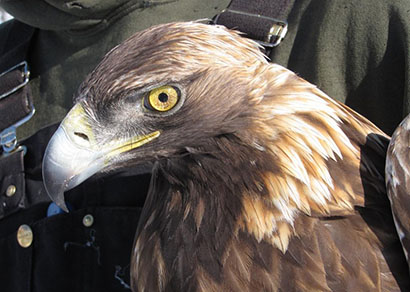
Golden Eagles are notoriously difficult to catch. As powerful and sharp-eyed as Bald Eagles, they live for decades and are wary and resourceful. Alaska biologists were thwarted in their initial efforts to capture Golden Eagles, but a carefully crafted strategy enabled researchers to capture 69 eagles in recent years and tag 53 with GPS tracking devices. What they learned, combined with counts of migrating eagles, revealed that Golden Eagles are far more abundant in Alaska than previously thought. New insights into their nesting, migration and population densities are proving valuable in the development of wind-generated electricity.
“There’s been a big push in recent years to better understand Golden Eagles, largely because of wind power development,” said state wildlife biologist Travis Booms, with Fish and Game’s Threatened, Endangered, and Diversity (TED) Program.
Golden Eagle research in Alaska is a collaborative effort between the US Fish and Wildlife Service (USFWS), the National Park Service, and the Alaska Department of Fish and Game. The USFWS permits wind power development and mitigates “take” of Golden Eagles (accidental deaths). Understanding and managing eagle mortality requires counting eagles and knowing where they go, and their density and abundance on the landscape. That draws on the expertise of biologists who watch them in summer –swooping on prey on the tundra and raising eaglets in Alaska mountains, and who count them winging through barren passes in spring and fall migrations.
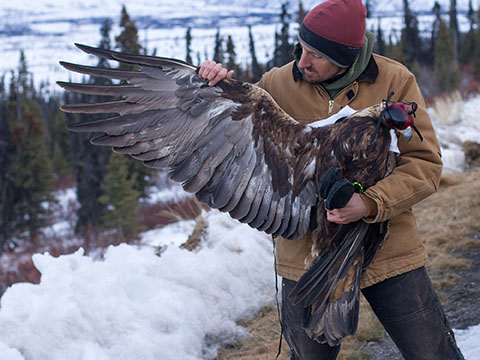
Tagging eagles – equipping them with small, backpack-style tracking devices – has been an important part of this work, said USFWS raptor biologist Steve Lewis. “There’s a big impetus, looking at migration funnels and where they winter,” Lewis said. Many Golden Eagles that nest in Alaska in summer spend winters in Wyoming, Montana, and Eastern Idaho and Eastern Washington – all windy places.
“Golden Eagles like windy places, which is where you put the windmills,” Booms said. “This is a learning process for wind development companies, where to site these wind turbines. Moving toward renewable energy is a good thing, but they were impacting bird populations, and the Golden Eagle is just one of many bird species impacted. “
Accurate location data from the GPS tags enables biologists to identify the routes eagles take when migrating. Lewis said that information is compared with the wind potential maps used by developers siting towers. “They can say, ‘We could move this over and the risk of hitting raptors could go way down.’ Locating towers a few hundred yards away can really make a difference in mortality.”
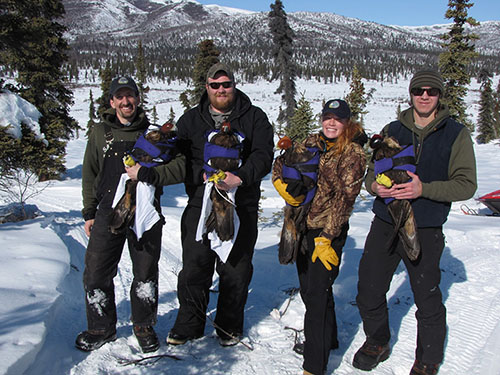
Those tags have also helped biologist estimate the number of Golden Eagles in Alaska. Booms and collaborators wrote a paper, soon to be published in the Journal of Raptor Research, “Golden Eagle Abundance in Alaska: Migration Counts and Movement Data Generate a Conservative Population Estimate.”
Their estimate of almost 13,000 Golden Eagles indicates Alaska is likely home to a quarter of the entire US population.
Golden Eagles: The Bald Eagle’s Interior Sibling
Think of the golden as the Bald Eagle’s Interior sibling, Booms said. Golden Eagles favor open country and mountains instead of beaches and water, and catch hares and ground squirrels, ducks and ptarmigan, instead of fish. Like Bald Eagles, they build large platform stick nests, but they nest on cliffs rather than trees. Typically, a clutch of just two eggs is laid, usually with only one eaglet fledging. Mortality is high for young eagles and fewer than half survive their first year.
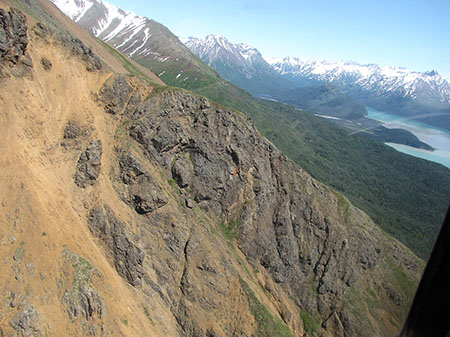
Bald Eagles are well-known scavengers and Golden Eagles are more predatory – although they do scavenge extensively in winter. They also take young animals opportunistically. “They’ll go after caribou calves, sheep lambs, goat kids,” Lewis said. They’ll harass a mother with young, testing to see if they can separate them or harry it off a cliff. They are very fast, especially in a stoop (dive).
They are extremely efficient, adaptable predators, Booms said. “They have good memories and live a long time,” he said. “Some specialize, just as human hunters do, and they use what they learn over their life. They learn through trial and error - what a ptarmigan is going to do, how it will flush, and they use terrain to sneak up.”
They’re relatively common in Alaska’s mountainous areas, Lewis said. “You may not see a lot of Golden Eagles in Denali, but a lot of Golden Eagles see you.” They are wary of people, relatively solitary, and don’t concentrate like bald eagles because their prey isn’t concentrated.
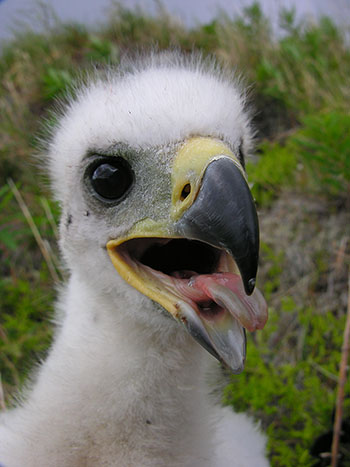
Golden Eagles are found throughout the state in summer but favor the western Alaska Mountain Range, and parts of the Talkeetna, Chugach, Kenai ranges, and to a lesser extent, the Kuskokwim mountain range. Some overwinter in Alaska.
“People think of birds as being migratory or not, but we learned some will migrate out and some will stay one year and not another,” Booms said. “A small minority decides to stay each year, probably based on food availability. Snowshoe hares are a primary prey, and when the cycle is high, probably more stay. When they crash, probably far fewer stay.”
The eagles migrate along established routes. In Southcentral Alaska, a pass between the Chugach and Talkeetna Mountains funnels eagles moving west in the spring. Eagles concentrated there near Gunsight Mountain and Tahneta Pass are counted by on-the-ground observers.
Biologists with the nonprofit research group Hawkwatch International conducted spring migration counts in 2016 and 2018. USFWS biologist Steve Lewis and state biologists collaborated to count eagles and better understand their abundance in Alaska. They saw a surprising number of eagles during the weeks spent in those chilly, wind-swept passes - 900 to 1,200 Golden Eagles.
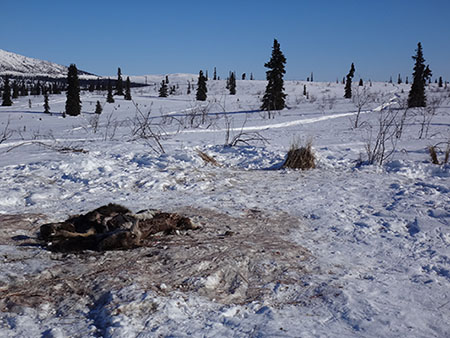
Booms said the numbers were remarkable. “That’s a really high number for a migration station, nationally,” Booms said. “That’s one of the unique attributes of Gunsight, the numbers they see there. And that’s why we went there to tag them.”
Catching Eagles at a “wolf kill site”
Golden Eagles are sometimes captured for research purposes and a very small number are used as hunting birds in falconry. The Fish and Wildlife Service permits falconers to catch five Golden Eagles nationally per year. “But none in Alaska,” Booms said, “because there has to be a depredation issue where eagles are identified as problematic in catching and killing livestock, usually sheep.”
The conventional method involves setting up a trap at night near a nest during the breeding season. “That doesn’t work in Alaska because it doesn’t get dark in the summer,” Booms said. He and his colleague Chris Barger, also a Fish and Game biologist, were unsuccessful in 2013 – two weeks of effort at Gunsight didn’t net a single bird.
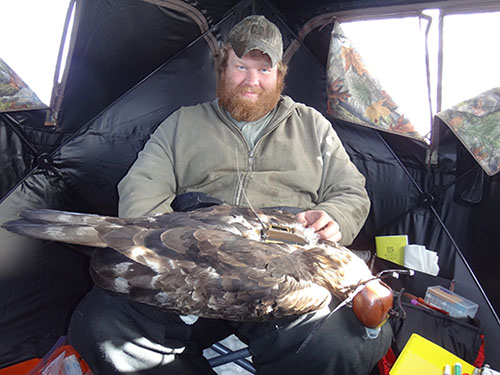
“The next year we doubled down,” Booms said. “We spent a lot of time preparing - we improved the trap, improved the bait, and the blind. It’s the little details, like minute placement of the trap, the trigger line, that makes or breaks it. You succeed or fail in your effort months before you start.”
Booms said they initially used a small launcher to throw a 10-foot by 10-foot net, something similar to what’s used to launch a “dummy” for training retrieving dogs.
“We learned that visually, that launcher scared eagles off. It looked out of place in the snow.,” Booms said. “Golden Eagles didn’t come to the bait. Adults know how to detect and kill prey, and they’ve been doing it for years. They avoid threats, so why come to this funny looking bait pile with the weird box next to it?”
“As a trapper, you need to be thinking about the animal you are trying to catch. You need to understand the little details - why does an animal put its foot here and not there? The same thing applies to science.”
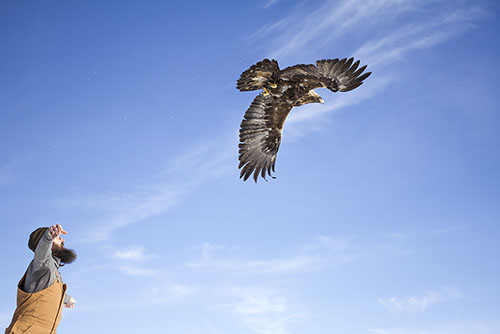
They minimized the visibility of anything not natural and maximized the visibility of everything (supposed to look) natural. They got a bigger net and a more powerful launcher and hid it well. They sprayed everything white, covered the launcher and disguised it with snow and tall, dry marsh grass harvested in the fall.
“We also went big on bait,” Booms said. “Eagles like fresh bait. They’ll eat rotten meat if they’re really hungry, but they prefer fresh, red meat. That made a huge difference, that pulled the eagles down.”
Fish and Game’s veterinarian Dr. Kimberlee Beckmen made sure the moose meat and blood they used was safe and free of pathogens. When it came time to set up the trap, they designed a “kill site.” They stomped out a big area with snowshoes, a disturbance eagles could spot from a distance, and spread blood and fur around the meat.
“We tried to make it look natural, like a wolf kill. Just what a Golden Eagle would encounter in the wild, like a pack of wolves came in and killed a moose and left,” Booms said. “We also went out and pre-baited, so we had magpies and ravens coming in. The flash of a magpie, eagles key in on that. When five or six magpies are on a carcass, it’s a visual clue for predators.”
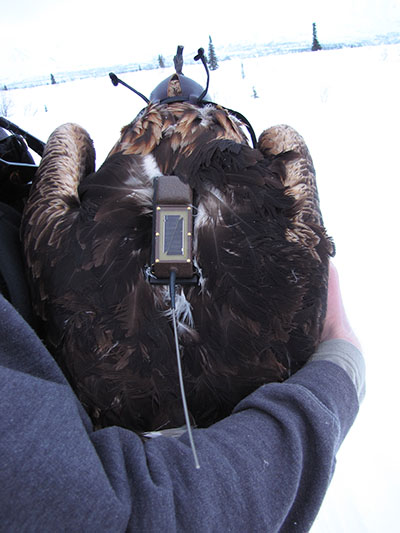
They returned in 2014 and caught 15 Golden Eagles in about two weeks. “We were elated,” he said. “We put transmitters on all the birds.” Over the next three years they caught a total of 69 Golden Eagles, almost all adult birds, and tagged 53 with transmitters. The collaborative research project with the US Fish and Wildlife Service and National Park Service made a huge leap forward.
A bird in the hand
With the stage set, Booms and Barger were ready for action. They hid in a snow-camouflaged blind a half-mile away from the set, with their snow machine covered by a white sheet. Eagles are quick, so they applied a strategy. When an eagle landed on the bait, they let it eat. Maybe a pound of meat, Booms said, that slows down a ten-pound eagle and makes a big difference when it takes off. When they hit the trigger, the net was launched over the eagle, capturing it as it jumped up. Booms said it took less than a minute to snowmachine up the net.
A Golden Eagle can do serious damage, Booms said. It can put a talon through an arm, thigh, or abdomen. You must handle them very carefully.
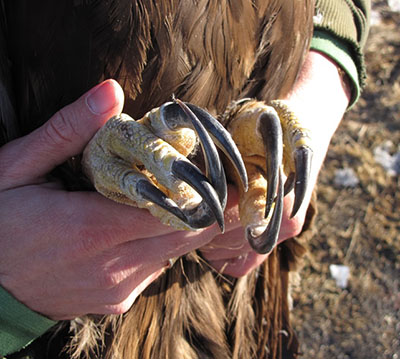
“The focus is the feet, you don’t worry about the beak,” he said. “Bald Eagles are biters; Golden Eagles are not. They fight with their feet. First thing, you grab their feet, secure their feet, then put a hood over their head. That calms them significantly, their heartbeat slows, and their stress response is reduced.”
Booms said they cut them out of the net, as they didn’t want to take time to untangle them. The eagle was then placed in a falconry device called an abba, a cloth vest that keeps their wings tucked in and their legs in a natural position. They reset the trap and snowmachined back to the blind where they equipped the bird with a backpack-style harness that carries the transmitter in the center of its back.
“We make a custom harness for each individual eagle,” he said. “We want it to be comfortable, since the eagle will be wearing it the rest of its life.”
Counting Eagles
Questions about Golden Eagles in Alaska include how many are out there, what are their movements, how many chicks do they have and what is their survival, and how long to do birds live. Federal biologists have been working on breeding surveys, and state and federal biologists collaborated to learn more about numbers.
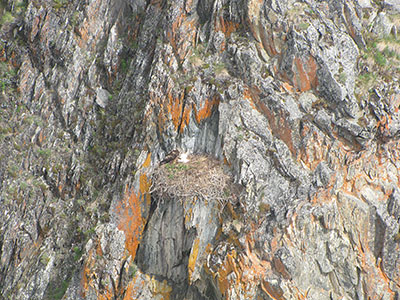
Lewis and Booms said raptor biologist Carol McIntyre with National Park Service is Alaska’s Golden Eagle expert. “She did the first movement study and pioneered the first attempts to understand how Golden Eagles move and where they go,” Booms said. “Our work really built on her foundation of Golden Eagle work in Alaska.”
In 2009, the US Fish and Wildlife Service estimated Alaska’s summer population of Golden Eagles to be 2,400 individuals. But biologists knew the Alaska population was undercounted, and they wanted to improve that estimate. In the fall of 2014, Lewis and McIntyre counted about 1,400 Golden Eagles along the Nebesna road in Wrangell-St. Elias National Park and Preserve. Seeing that many eagles in a couple weeks at one spot indicated the Alaska population was likely much higher than 2,400, especially given the amount of good Golden Eagle habitat in Alaska.
Combining movement data from the tagged birds, the migration counts, and knowing where eagles summer and the area eagles occupy in Alaska provided the information to make a more accurate estimate. They estimate 12,717 Golden Eagles of all ages are in Alaska annually, and propose this as a conservative statewide population estimate. This is three to five times larger than previous estimates and likely represents about one quarter of the US population.
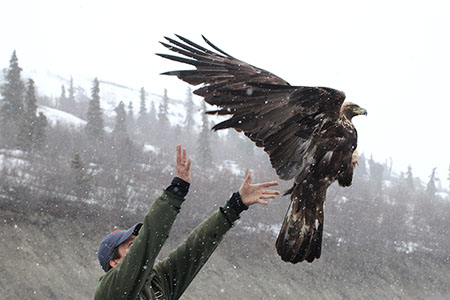
Booms said for a nongame biologist working on declining species or species of management concern, it’s rare to find more animals in your research than what others thought were present.
Golden Eagle Species Profile, Alaska Department of Fish and Game
More on Hawkwatch International
The Ecology of Golden Eagles in Denali National Park
Support Conservation with the Conservation Stamp
Subscribe to be notified about new issues
Receive a monthly notice about new issues and articles.
